What'sNEW Oct - Dec 2022
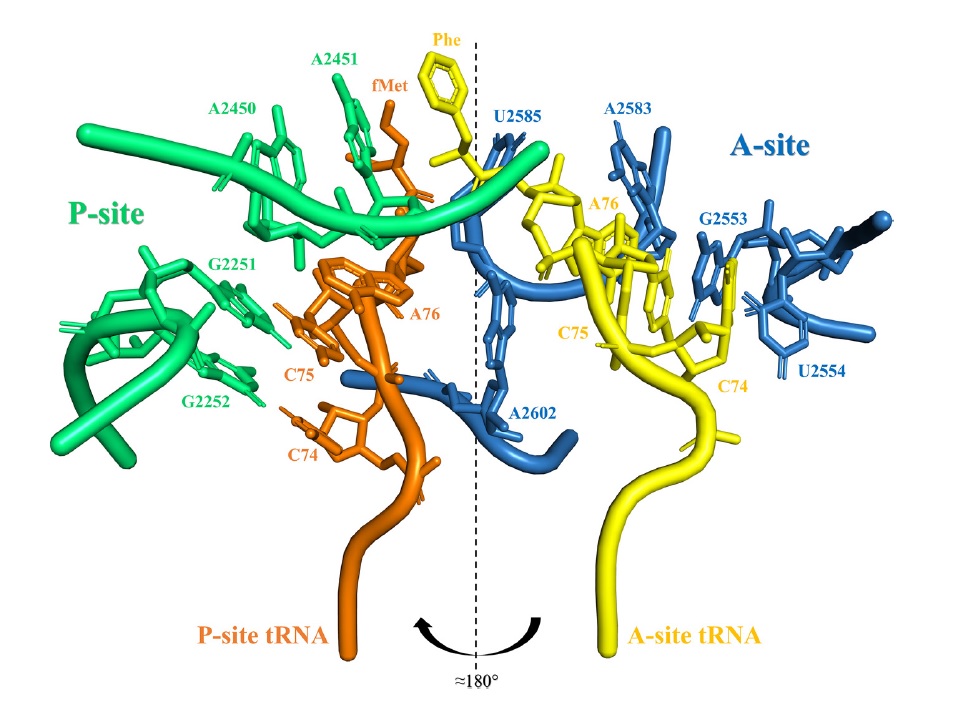 The PTC [Peptidyl Transferase Center] has ...virtually survived unchanged over 4 billion years of evolution.... This comment comes in a study of the ribosome by George Fox's team at the University of Houston. A leading expert on ribosomes, Fox is now focussed on how they evolved. His group's research is on the cutting edge for exploring the "RNA World."
The PTC [Peptidyl Transferase Center] has ...virtually survived unchanged over 4 billion years of evolution.... This comment comes in a study of the ribosome by George Fox's team at the University of Houston. A leading expert on ribosomes, Fox is now focussed on how they evolved. His group's research is on the cutting edge for exploring the "RNA World."
The ribosome is a big molecular machine that assembles proteins within cells. At its heart is the Peptidyl Transferase Center, where amino acid residues are connected, one-by-one. At a crucial step, the inner chamber of the PTC (illustrated, right) rotates 180 degrees to carry its tiny cargo forward. This by itself is amazing.
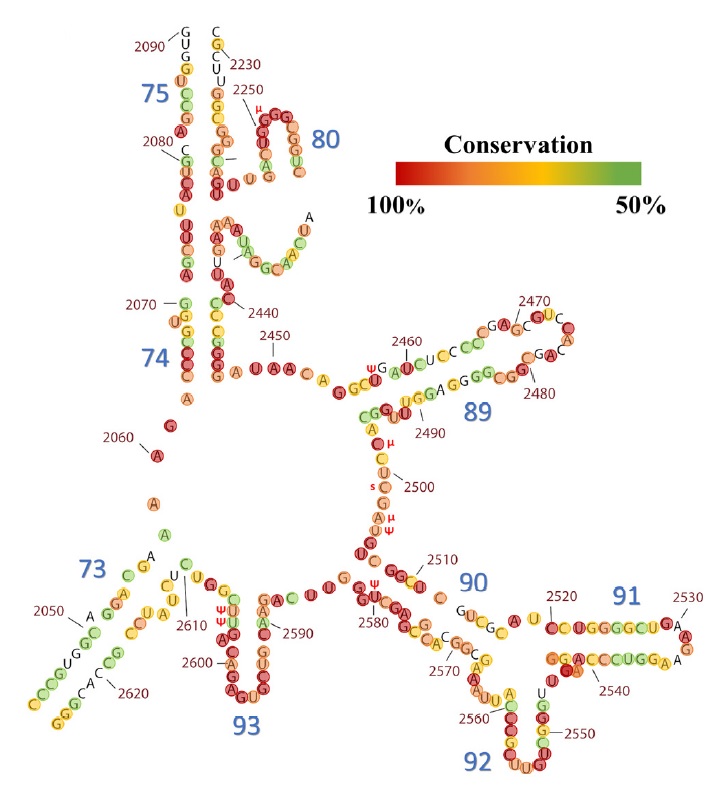
The current literature review is focused on the nature of the extant PTC and its proposed ancestor, the proto-ribosome, with 14 pages of illustrated text and 275 references. It observes that that some parts of the ribosome are able to retain function independently. Important metal ions may have been even more important earlier. Some RNA nucleotides may be substituted without harm (see left). They elaborate:
"In one study on yeast ribosomes, the rRNA mutations involving universally or highly conserved bases in the PTC region resulted in subtle structural rearrangements. However, these changes had a minimal effect on the overall translational accuracy, aminoacyl-tRNA binding, or PTC activity. Thus, the extant PTC rRNA could accommodate a certain level of plasticity without affecting the overall PTC function. Such plasticity could well be attributed to the functional groups and likely be a clue to its functionally generalized pasts. ...Overall, the structural organization of the extant PTC is characterized by a property defined as an "induced-fit mechanism" (conformational change). ...Such a mechanism, in turn, is thought to confer an extraordinary ability to the ribosome to handle substrates of various sizes."
For a proposed historical reconstruction of evolution at the molecular level, this is as good as it gets. But there is room for doubt about the whole line of research. Even the suggestions from these world experts are gappy and speculative. At this rate, the RNA World seems unlikely to explain the origin-of-life in this century. I suspect George Fox would agree.
I think a more fruitful question is "Where does life come from?" Methodical pursuit of this question makes panspermia a viable possibility. The Houston research team is fully aware of panspermia and many of its implications, but they pay insufficient attention to their own observation quoted first above. Maybe life was there all along,
 "The Peptidyl Transferase Center: a Window to the Past," by Madhan R. Tirumalai, Mario Rivas, Quyen Tran and George E. Fox, doi:10.1128/MMBR.00104-21, Microbiology and Molecular Biology Reviews, Dec 2022. "The Peptidyl Transferase Center: a Window to the Past," by Madhan R. Tirumalai, Mario Rivas, Quyen Tran and George E. Fox, doi:10.1128/MMBR.00104-21, Microbiology and Molecular Biology Reviews, Dec 2022.
 George Fox, Department of Biology and Biochemistry, University of Houston.
29 Dec, Fox replies, "Although the PTC might appear to be from an RNA World I think most of us think there was an RNA-peptide world Very early." George Fox, Department of Biology and Biochemistry, University of Houston.
29 Dec, Fox replies, "Although the PTC might appear to be from an RNA World I think most of us think there was an RNA-peptide world Very early."
 The RNA World and Other Origin-of-Life Theories has history and updates. The RNA World and Other Origin-of-Life Theories has history and updates.
 13 March 2012: more about a posible RNA-peptide world, with more problems. 13 March 2012: more about a posible RNA-peptide world, with more problems.
 Testing Darwinism versus Cosmic Ancestry has relevant discussion. Testing Darwinism versus Cosmic Ancestry has relevant discussion.
 "Mobile genetic elements from the maternal microbiome shape infant gut microbial assembly and metabolism", doi:10.1016/j.cell.2022.11.023, by Tommi Vatanen et al., Cell, 15 Dec 2022; and commentary:
"Evidence of horizontal gene transfer between human maternal microbiome and infant gut microbiome," EurekAlert!, 22 Dec 2022. "Mobile genetic elements from the maternal microbiome shape infant gut microbial assembly and metabolism", doi:10.1016/j.cell.2022.11.023, by Tommi Vatanen et al., Cell, 15 Dec 2022; and commentary:
"Evidence of horizontal gene transfer between human maternal microbiome and infant gut microbiome," EurekAlert!, 22 Dec 2022.
 Viruses and Other Gene Transfer Mechanisms has updates with thousands of examples of HGT. Viruses and Other Gene Transfer Mechanisms has updates with thousands of examples of HGT.
Our proposal has the advantage that it would reduce the cost of directed panspermia and augment the effectiveness of natural cometary panspermia.
These words come in in the December issue of Astrobiology, in one of ten articles about panspermia. Here, McKay et al. wonder about "directed panspermia," using comets as the transport system. I would call it "intentional panspermia," because comets are hard to steer — although they think about that, too. By the way, the proposal does not alter the arguments for naturally occurring panspermia by comets. We weren't worried.
The writers consider a wide range of issues, often referencing quantitative analysis. Comets, hardy bacteria, various technologies, planetary protection, life detection and ethical questions all come under discussion. Well worth reading. Among the other articles, several deal directly with the recent interstellar visitor, 'Oumuamua. Another article (reviewed yesterday) gives a concise history of panspermia.
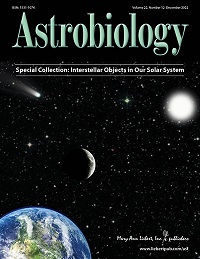
 Directed Panspermia Using Interstellar Comets by Christopher P. McKay, Paul C.W. Davies, and Simon P. Worden, Astrobiology, Dec 2022 Directed Panspermia Using Interstellar Comets by Christopher P. McKay, Paul C.W. Davies, and Simon P. Worden, Astrobiology, Dec 2022
 Astrobiological Implications of Interstellar Material in the Solar System [ToC], special issue of Astrobiology, edited and introduced by Paul C.W. Davies and S. Peter Worden, online 06 Dec 2022. Astrobiological Implications of Interstellar Material in the Solar System [ToC], special issue of Astrobiology, edited and introduced by Paul C.W. Davies and S. Peter Worden, online 06 Dec 2022.
 How is it Possible? includes Cosmic Ancestry's early speculations about comets intentionally seeded with life, and — when a lifeless body becomes exposed — the roles of extremophiles, Gaia and HGT. How is it Possible? includes Cosmic Ancestry's early speculations about comets intentionally seeded with life, and — when a lifeless body becomes exposed — the roles of extremophiles, Gaia and HGT.
 Gaia, Gaia,
 Bacteria: The Space Colonists and Bacteria: The Space Colonists and
 Comets: The Delivery System are related. Comets: The Delivery System are related.
...Richter's [panspermia] had several commendable characteristics: in a nod to Pasteur it had removed spontaneous generation; it embraced Darwinism without having to explain the origin of life on a lifeless Earth; and it did not invoke supernatural agents. This excerpt comes from Simon Mitton's history of panspermia in Astrobiology. The history is very well-researched and -referenced, beginning with Anaxagoras. Mitton is quite informative about some of panspermia's 19th century advocates and their variety of versions, and about carbonaceous meteorites.
Mitton is not confined by the usual assumptions. For example, he mentions the logic that leads to life with no origin. He is aware that organics in meteorites may be remnants of biology. He admits that evolution and the origin-of-life have shared difficulties. And he fully acknowledges the contributions of Chandra Wickramasinghe and Fred Hoyle.
 A Short History of Panspermia from Antiquity Through the Mid-1970s by Simon Mitton, Astrobiology, Dec 2022 A Short History of Panspermia from Antiquity Through the Mid-1970s by Simon Mitton, Astrobiology, Dec 2022
 Hoyle and Wickramasinghe's Analysis of Interstellar Dust has more about them. Hoyle and Wickramasinghe's Analysis of Interstellar Dust has more about them.
 Introduction: More Than Panspermia includes a brief history. Mitton's has more. Introduction: More Than Panspermia includes a brief history. Mitton's has more.
| 01 Dec 2022 | What'sNEW about HGT  | |
|
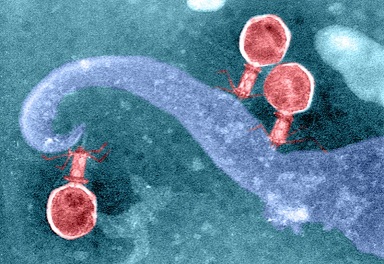
 Diverse virus-encoded CRISPR-Cas systems include streamlined genome editors, by Basem Al-Shayeb et al., doi:10.1016/j.cell.2022.10.020, Cell, 23 Nov 2022. Diverse virus-encoded CRISPR-Cas systems include streamlined genome editors, by Basem Al-Shayeb et al., doi:10.1016/j.cell.2022.10.020, Cell, 23 Nov 2022.
 CRISPR tools found in thousands of viruses..., Nature News, 23 Nov 2022. CRISPR tools found in thousands of viruses..., Nature News, 23 Nov 2022.
 Viruses and Other Gene Transfer Mechanisms has a primer and many examples of HGT. Viruses and Other Gene Transfer Mechanisms has a primer and many examples of HGT.
...what's needed is proof-by-example (quarantined biology) or proof-of-principle (digitally quarantined computer models). This is my refrain to the mainstream theory of evolution, because these proofs are conspicuously missing. Although the "mainstream" is actuallty quite fractured nowadays, it unanimously clings to a core belief that life can originate from ordinary chemicals and make ongoing macroevolutionary progress on a quarantined, initially lifeless planet. Without proof, it is reasonable to doubt the core belief. In fact, half the population, including many well-informed experts, do doubt it.
I have promoted tests that might satisfy these lacks, without serious takers. And I have often discussed the lack of proof with mainstream biologists. These discussions have not been fruitful. The issue is not squarely faced, or evidence for historical evolution is touted as proof. Doubters are dismissed as uninformed or unscientific. Many experts who share the doubts do not participate in the discussion because they have learned that it is unproductive and uncivil. I'm getting there, following another lengthy exchange, this time with a published theoretical biologist. I spent a lot of effort on this cross-paradigm conversation, but it went nowhere. My side of it is the latest entry in "Replies".
 Sep - Nov 2022: emails with Adam S. Wilkins. Sep - Nov 2022: emails with Adam S. Wilkins.
| 14 Nov 2022 | What'sNEW about HGT
 | |
|
The importance of HGT among prokaryotes is already well-established, but this example deserves notice:
 Virus-derived gene transfer agents benefit host cells by providing templates for DNA repair by Andrew S. Lang, PLoS Biol, 08 Nov 2022; re: Virus-derived gene transfer agents benefit host cells by providing templates for DNA repair by Andrew S. Lang, PLoS Biol, 08 Nov 2022; re:
 Prophage-like gene transfer agents promote Caulobacter crescentus survival and DNA repair during stationary phase by Kevin Gozzi et al., PLoS Biol, 03 Nov 2022. Prophage-like gene transfer agents promote Caulobacter crescentus survival and DNA repair during stationary phase by Kevin Gozzi et al., PLoS Biol, 03 Nov 2022.
 10 Mar 2021: New hub affirming HGT among prokaryotes, with links. 10 Mar 2021: New hub affirming HGT among prokaryotes, with links.
 ...scientists are pretending they have the answer ...when natural selection couldn't possibly have produced such a machine. — Kurt Vonnegut, 2006
...scientists are pretending they have the answer ...when natural selection couldn't possibly have produced such a machine. — Kurt Vonnegut, 2006
 Remembering author Kurt Vonnegut, who would have turned 100 on Friday, 7-minute excerpt of interview, Morning Edition, NPR, 11 Nov 2022. Remembering author Kurt Vonnegut, who would have turned 100 on Friday, 7-minute excerpt of interview, Morning Edition, NPR, 11 Nov 2022.
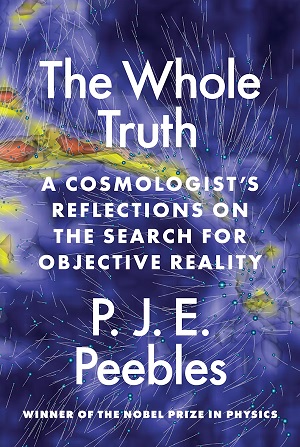 The Whole Truth, by P.J.E Peebles, is an instructive story about the currently favored model for cosmology, designated ΛCDM, "lambda cold dark matter." Peebles earned a Nobel prize in 2019 for his contributions to that model. In it, today's universe grew from an earlier, hot, dense phase and most of its mass appears to be non-baryonic. These ideas are supported by multiple lines of evidence from diverse sources using different methods, he writes. The presentation is forceful, but polite and undogmatic. For example, he admits that different methods find different values for the Hubble constant. I learned a lot from the book, and I am grudgingly accepting the case for a hot dense earlier phase of the universe. I must confess, some of Peebles went over my head on first reading. Don't ask me to explain "tilt".
The Whole Truth, by P.J.E Peebles, is an instructive story about the currently favored model for cosmology, designated ΛCDM, "lambda cold dark matter." Peebles earned a Nobel prize in 2019 for his contributions to that model. In it, today's universe grew from an earlier, hot, dense phase and most of its mass appears to be non-baryonic. These ideas are supported by multiple lines of evidence from diverse sources using different methods, he writes. The presentation is forceful, but polite and undogmatic. For example, he admits that different methods find different values for the Hubble constant. I learned a lot from the book, and I am grudgingly accepting the case for a hot dense earlier phase of the universe. I must confess, some of Peebles went over my head on first reading. Don't ask me to explain "tilt".
Of course, cosmic ancestry is at odds with the consensus big bang theory, because a beginning from a super-hot single point, with nowhere to hide, would sterilize everything. Fortunately, Peebles also wonders what the universe was doing before it was expanding, and says that we have no coherent theory of the "beginning" of the universe. Good.
I was pleased to learn that Mach's challenging skepticism had lasting influence, and to learn more about Einstein's path to General Relativity. George Gamow's role in the development of today's cosmology was bigger than I knew. Fred Hoyle's multiple contributions are acknowledged and explained. Cosmology is a collaborative enterprise, and Peebles knows who contributed what, when.
Peebles has a lot to observe about how science advances. Some discoveries come almost simultaneously from different scientists, "Merton's multiples," he names them. Some ideas are originally accepted for their elegance and simplicity. Some insights are simply "in the air." Major breakthroughs usually come from "small science," whose papers have only a few authors. His examples come from cosmology, but the book is largely about the logic and philosophy of science in general. I also think about that subject, with examples from a different field, evolution. The contrast is striking:
While cosmologists may work independently, they heed others and notice evidence from any source that may be relevant. If an anomaly arises, it is investigated. Resolving differences is an unstated, obvious goal. And the assumptions underlying the whole enterprise are not exempt from scrutiny. This freedom keeps the subject healthy and lively. By comparison, today's theory of evolution is ridgidly blindered, gridlocked.
Peebles writes "a 'persuasive case' [applies] to theories that pass enough tests of prediction to persuade the community to accept the theory...." By that criterion, the Modern Synthesis (including EES, etc.) is obviously not persuasive. Its defenders respond that the unpersuaded are not members of "the community."
"At the heart of the science wars is surely the difficulty of communication between different cultures with different traditions," Peebles says, referring to conflict with "anti-science." A skeptical alternative such as cosmic ancestry is not "anti-science," but mainstream biology frames all skepticism that way. "The mismatch makes fertile ground for misunderstandings," Peebles concludes. These words come from a distinguished scientist who well understands the practice of science. Highly recommended.
 The Whole Truth: A Cosmologist s Reflections on the Search for Objective Reality by P. J. E. Peebles, Princeton University Press, 02 Aug 2022. The Whole Truth: A Cosmologist s Reflections on the Search for Objective Reality by P. J. E. Peebles, Princeton University Press, 02 Aug 2022.
 21 Nov 2019: comments from an interview with James Peebles. 21 Nov 2019: comments from an interview with James Peebles.
 The End and the Big Bang includes evidence inconsistent with a hot big bang from a single point. The End and the Big Bang includes evidence inconsistent with a hot big bang from a single point.
 06, 14 Mar 2023: cosmologist George Nickas has further comments. 06, 14 Mar 2023: cosmologist George Nickas has further comments.
| 04 Nov 2022 | What'sNEW about HGT
 | |
|
...the whitefly... has acquired no less than 49 genes through at least 24 events of HGT from plant sources.
 Multiple Horizontal Acquisitions of Plant Genes in the Whitefly Bemisia tabaci by Clément Gilbert and Florian Maumus, Genome Biology and Evolution, Oct 2022. Multiple Horizontal Acquisitions of Plant Genes in the Whitefly Bemisia tabaci by Clément Gilbert and Florian Maumus, Genome Biology and Evolution, Oct 2022.
 26 Mar 2021: more about transferred whitefly genes. 26 Mar 2021: more about transferred whitefly genes.
 Viruses and Other Gene Transfer Mechanisms has a primer and many updates with examples. Viruses and Other Gene Transfer Mechanisms has a primer and many updates with examples.
Science without humility and community slows our collective understanding.
 Weldon, Bateson, and the origins of genetics: Reflections on the unraveling and rebuilding of a scientific community by Lea K. Davis, PLoS Gen, 27 Oct 2022. Weldon, Bateson, and the origins of genetics: Reflections on the unraveling and rebuilding of a scientific community by Lea K. Davis, PLoS Gen, 27 Oct 2022.
| 30 Oct 2022 | What'sNEW about HGT  | |
|
Science writers for Quanta take a wide look at HGT, with references and insights from recognized experts.
 How Genes Can Leap From Snakes to Frogs in Madagascar by Veronique Greenwood, Quanta, 27 Oct 2022. How Genes Can Leap From Snakes to Frogs in Madagascar by Veronique Greenwood, Quanta, 27 Oct 2022.

 28 Apr 2022: about the original study of retroposons transferred from snakes to frogs. 28 Apr 2022: about the original study of retroposons transferred from snakes to frogs.
 Viruses... cites more than 2,000 examples of HGT, including every gene category. Viruses... cites more than 2,000 examples of HGT, including every gene category.
 Thanks, Google Alerts and Adam S. Wilkins. Adam, please notice also: Thanks, Google Alerts and Adam S. Wilkins. Adam, please notice also:
 Scientists Catch Jumping Genes Rewiring Genomes, by Max Kozlov, Quanta, 12 May 2021. Scientists Catch Jumping Genes Rewiring Genomes, by Max Kozlov, Quanta, 12 May 2021.
On Christmas Eve, 2021, the seismometer on the Mars Insight Lander detected an unusual jolt. Photos from the Mars Reconnaissance Orbiter, examined later, provided a sure explanation. A photograph taken Christmas Day showed a fresh meteor scar on Amazoni Planitia that had not been there in the photo taken the day before. Later study of high-resolution images showed that chunks of water-ice had been scattered by the impact. (NASA did not anticipate finding water so close to the equator.)
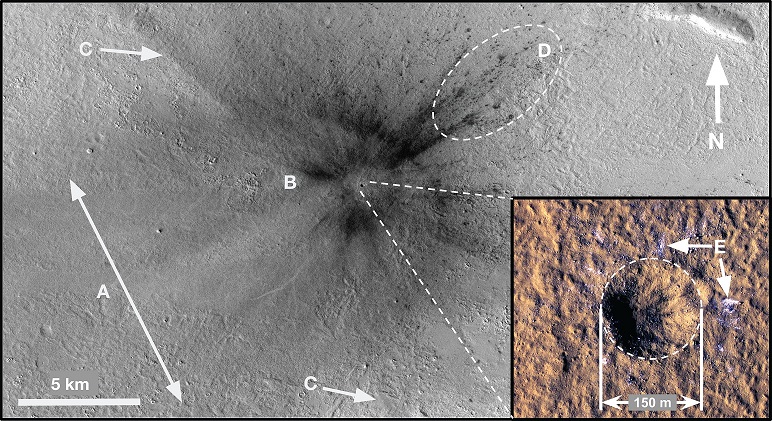
 Surface waves and crustal structure on Mars by Doyeon Kim et al., and Surface waves and crustal structure on Mars by Doyeon Kim et al., and
 Largest recent impact craters on Mars: Orbital imaging and surface seismic co-investigation by L. V. Posiolova et al., Science, 27 Oct 2022. Largest recent impact craters on Mars: Orbital imaging and surface seismic co-investigation by L. V. Posiolova et al., Science, 27 Oct 2022.
 ...It Came From Space. by Kenneth Chang, The New York Times, 27 Oct 2022. ...It Came From Space. by Kenneth Chang, The New York Times, 27 Oct 2022.
 Thanks, Rob Cooper. Thanks, Rob Cooper.
 Life on Mars!, cites various, noteworthy evidence. Life on Mars!, cites various, noteworthy evidence.
 Extremophiles on Mars could survive for hundreds of millions of years by Keith Cooper, Space,com +Scientific American, 25 Oct 2022; re: Extremophiles on Mars could survive for hundreds of millions of years by Keith Cooper, Space,com +Scientific American, 25 Oct 2022; re:
 Effects of Desiccation and Freezing on Microbial Ionizing Radiation Survivability... by William H. Horne et al., Astrobiology, online 25 Oct 2022. Desiccation and freezing greatly increased radiation survival.... Effects of Desiccation and Freezing on Microbial Ionizing Radiation Survivability... by William H. Horne et al., Astrobiology, online 25 Oct 2022. Desiccation and freezing greatly increased radiation survival....
 Bacteria..., and Bacteria..., and
 Life on Mars!, have background and updated information. Life on Mars!, have background and updated information.
 Thanks, Google Alerts and George Nickas. Thanks, Google Alerts and George Nickas.
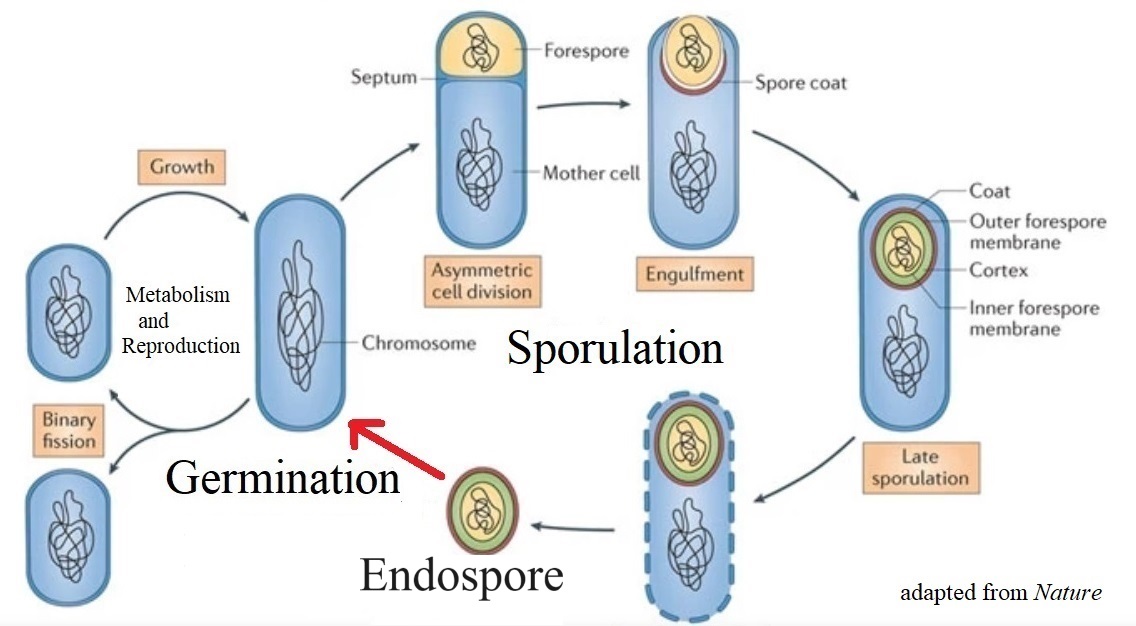 Many bacteria can enter a state of dormancy by the process of Sporulation (right side of illustration). An Endospore can survive many environmental threats and persist indefinitely with no metabolism. When it's safe again, Germination (red arrow) is initiated, and Metabolism and Reproduction resume (left).
Many bacteria can enter a state of dormancy by the process of Sporulation (right side of illustration). An Endospore can survive many environmental threats and persist indefinitely with no metabolism. When it's safe again, Germination (red arrow) is initiated, and Metabolism and Reproduction resume (left).
New research suggests that the membrane protecting the spore stores electrical energy as a "biological capacitor," accumulating and integrating signals from the environment while the spore is chemically inert. Upon reaching a threshold, the capacitor triggers Germination and the cell resumes normal life. Of course, this would be crucial for panspermia.
...short nutrient pulses result in step-like changes in the electrochemical potential of persistent spores. During dormancy, spores thus gradually release their stored electrochemical potential to integrate extracellular information over time. It would be hard to invent a neo-darwinian explanation for the programming underlying this capability.
 Electrochemical potential enables dormant spores to integrate environmental signals by Kaito Kikuchi et al., Science, 06 Oct 2022. Electrochemical potential enables dormant spores to integrate environmental signals by Kaito Kikuchi et al., Science, 06 Oct 2022.
 An electric alarm clock for spores by Jonathan Lombardino and Briana M. Burton, Science, 06 Oct 2022. An electric alarm clock for spores by Jonathan Lombardino and Briana M. Burton, Science, 06 Oct 2022.
 ...How Dormant Bacteria Calculate Their Return to Life, UC San Diego (+Newswise), 06 Oct 2022. ...How Dormant Bacteria Calculate Their Return to Life, UC San Diego (+Newswise), 06 Oct 2022.
 Bacteria: The Space Colonists has background and updates about their hardiness. Bacteria: The Space Colonists has background and updates about their hardiness.
 Robust Software Management begins with a brief discussion of endospores. Robust Software Management begins with a brief discussion of endospores.
Cosmic ancestry, if even approximately correct, would require a Kuhnian paradigm shift in biology. Mainstream biology is not ready to consider a theory so different. For now, the occasional cross-paradigm conversations may be instructive to notice. They illustrate how difficult it is to reach understanding when underlying beliefs are so divergent.
|
...Think with me for a moment about quantum theory. It began by creating a canyon-size gap in physics. But Bohr and Einstein never quit talking. Crucial experiments (Bell's Inequality) seemed to leave the old philosophy unworkable, yet questions remained unsettled until every possible alternative explanation had been explored. Turns out, yes, the old philosophy is unworkable. A new philosophy must replace it. And no one thinks this philosophy is complete. Dialog was fruitful and continues to be.
Now think about today's theory of evolution. There are profound disagreements, but each side talks only with itself. Experiments (Lenski et al.) are interpreted in conflicting ways, without collaborative scrutiny. In my opinion, scientific principles and practice are being ignored. If science is abandoned, you "hand the victory" to your anti-science opponents, as Fred Hoyle remarked:
 excerpt from exchange with biochemist and molecular biologist James Shapiro, Jun-Sep 2022. Search for Think with me excerpt from exchange with biochemist and molecular biologist James Shapiro, Jun-Sep 2022. Search for Think with me
|
| 04 Oct 2022 |
What'sNEW about HGT
 | |
|
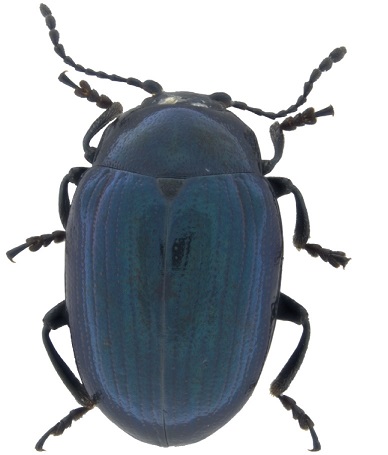 Horizontal gene transfer (HGT) provides an evolutionary shortcut for recipient organisms to gain novel functions. Although reports of HGT in higher eukaryotes are rapidly accumulating, in most cases the evolutionary trajectory, metabolic integration, and ecological relevance of acquired genes remain unclear.
Horizontal gene transfer (HGT) provides an evolutionary shortcut for recipient organisms to gain novel functions. Although reports of HGT in higher eukaryotes are rapidly accumulating, in most cases the evolutionary trajectory, metabolic integration, and ecological relevance of acquired genes remain unclear.
 Metabolic novelty originating from horizontal gene transfer is essential for leaf beetle survival by Roy Kirsch et al., doi:10.1073/pnas.2205857119, PNAS, 26 Sep 2022.
Also, a stinkbug benefits from cross-kingdom HGT. It seems to be everywhere. Metabolic novelty originating from horizontal gene transfer is essential for leaf beetle survival by Roy Kirsch et al., doi:10.1073/pnas.2205857119, PNAS, 26 Sep 2022.
Also, a stinkbug benefits from cross-kingdom HGT. It seems to be everywhere.
 A new antimicrobial peptide, Pentatomicin, from the stinkbug Plautia stali, by Yudai Nishide et al., Nature, 04 Oct 2022.
Notably, orthologous sequences were also detected from a horseshoe crab, cyanobacteria and proteobacteria, suggesting the possibility of inter-domain horizontal gene transfers of Pentatomicin and allied protein genes. A new antimicrobial peptide, Pentatomicin, from the stinkbug Plautia stali, by Yudai Nishide et al., Nature, 04 Oct 2022.
Notably, orthologous sequences were also detected from a horseshoe crab, cyanobacteria and proteobacteria, suggesting the possibility of inter-domain horizontal gene transfers of Pentatomicin and allied protein genes.
 Viruses... cites more than 2,000 examples of HGT, many crossing kingdoms. Viruses... cites more than 2,000 examples of HGT, many crossing kingdoms.
![]()
|
 The PTC [Peptidyl Transferase Center] has ...virtually survived unchanged over 4 billion years of evolution.... This comment comes in a study of the ribosome by George Fox's team at the University of Houston. A leading expert on ribosomes, Fox is now focussed on how they evolved. His group's research is on the cutting edge for exploring the "RNA World."
The PTC [Peptidyl Transferase Center] has ...virtually survived unchanged over 4 billion years of evolution.... This comment comes in a study of the ribosome by George Fox's team at the University of Houston. A leading expert on ribosomes, Fox is now focussed on how they evolved. His group's research is on the cutting edge for exploring the "RNA World."



 The Whole Truth, by P.J.E Peebles, is an instructive story about the currently favored model for cosmology, designated ΛCDM, "lambda cold dark matter." Peebles earned a Nobel prize in 2019 for his contributions to that model. In it, today's universe grew from an earlier, hot, dense phase and most of its mass appears to be non-baryonic. These ideas are supported by multiple lines of evidence from diverse sources using different methods, he writes. The presentation is forceful, but polite and undogmatic. For example, he admits that different methods find different values for the Hubble constant. I learned a lot from the book, and I am grudgingly accepting the case for a hot dense earlier phase of the universe. I must confess, some of Peebles went over my head on first reading. Don't ask me to explain "tilt".
The Whole Truth, by P.J.E Peebles, is an instructive story about the currently favored model for cosmology, designated ΛCDM, "lambda cold dark matter." Peebles earned a Nobel prize in 2019 for his contributions to that model. In it, today's universe grew from an earlier, hot, dense phase and most of its mass appears to be non-baryonic. These ideas are supported by multiple lines of evidence from diverse sources using different methods, he writes. The presentation is forceful, but polite and undogmatic. For example, he admits that different methods find different values for the Hubble constant. I learned a lot from the book, and I am grudgingly accepting the case for a hot dense earlier phase of the universe. I must confess, some of Peebles went over my head on first reading. Don't ask me to explain "tilt".


 Many bacteria can enter a state of dormancy by the process of Sporulation (right side of illustration). An Endospore can survive many environmental threats and persist indefinitely with no metabolism. When it's safe again, Germination (red arrow) is initiated, and Metabolism and Reproduction resume (left).
Many bacteria can enter a state of dormancy by the process of Sporulation (right side of illustration). An Endospore can survive many environmental threats and persist indefinitely with no metabolism. When it's safe again, Germination (red arrow) is initiated, and Metabolism and Reproduction resume (left).
 Horizontal gene transfer (HGT) provides an evolutionary shortcut for recipient organisms to gain novel functions. Although reports of HGT in higher eukaryotes are rapidly accumulating, in most cases the evolutionary trajectory, metabolic integration, and ecological relevance of acquired genes remain unclear.
Horizontal gene transfer (HGT) provides an evolutionary shortcut for recipient organisms to gain novel functions. Although reports of HGT in higher eukaryotes are rapidly accumulating, in most cases the evolutionary trajectory, metabolic integration, and ecological relevance of acquired genes remain unclear.
